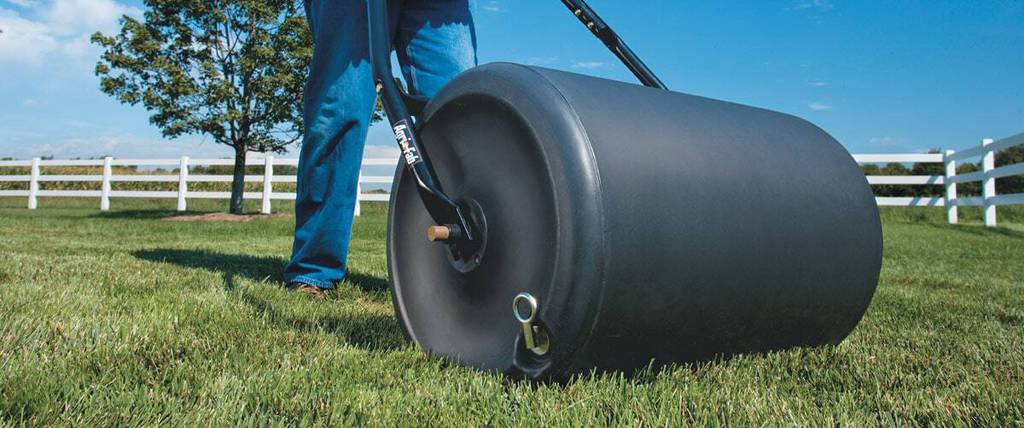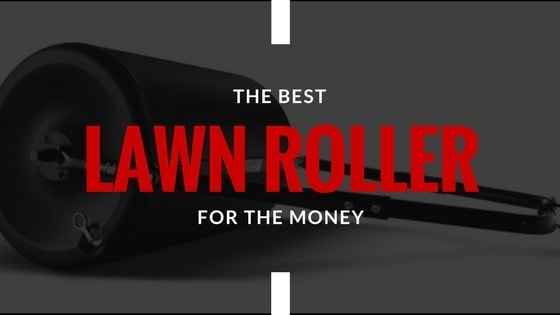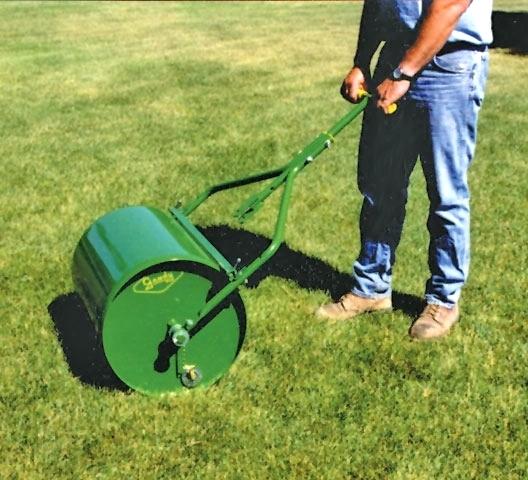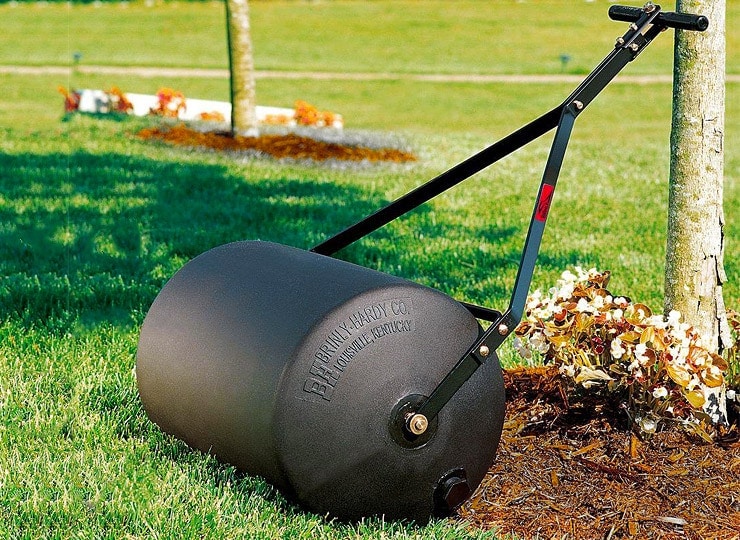
What’s the purpose for buying the best lawn roller for the money? We all know that if there’s one thing Americans are proud of, it’s their lawns. Having a big, beautiful lawn full of healthy grass is one of the most important parts of being a homeowner, and to maintain such a lawn, you need some tools to do it.
Everyone knows about the importance of mowing, edging, and fertilizing your grass. But there’s one tool that is often overlooked–a lawn roller often also referred to as a lawn leveler.
Having one might be more important than you think. A lawn roller is a tool that can mean the difference between an average lawn and the best yard in the neighborhood. In this guide, we will show you the best lawn roller for your money, as well as give some information about how lawn rollers work.
Quick Look: What Makes a Top Lawn Roller
Do you need a lawn roller?
One of the most often overlooked lawn care tools is a lawn roller. These sometimes obscure devices are usually attached to a riding lawnmower or tractor and drag behind as you drive around your lawn. If your having problems with weeds see my full review on the top weed killers.
How does a lawn roller work?
Lawn rollers work by flattening the top one or two inches of the grass and soil, which has many benefits (and potential drawbacks). First, it levels out lawns after the wintertime wreaks havoc with frost heaves that can move dirt. It also flattens down mole tunnels, earthworm tunnels, and any other disturbance.
What does a lawn roller do?
If you are seeding your lawn, a roller has the benefit of pressing grass seed into the soil to help it germinate faster. For spots in your yard that struggle to grow grass, this can mean the difference between having a beautiful lawn and having a nice dirt patch.
To create enough pressure for grass and soil compaction, you have to fill your lawn roller–which essentially is a specialized metal drum, made hollow in order to hold water or sand. Depending on the size, lawn rollers can be filled up with a lot of water or sand, and can be made as heavy as you need them to be.
Can you make a DIY lawn roller?
Thrifty homeowners often take the time to make their own lawn rollers. When making a DIY lawn roller, homeowners often use materials such as plywood and quick-drying concrete. It is a process. But a DIY lawn roller is an option to some.

Is a lawn roller for you?
Lawn rollers are used professionally on golf courses, baseball fields, and cricket pitches. You don’t necessarily want a lawn that is like a putting green or an infield, do you? Unless you have an ornamental lawn, it’s unlikely you need a large sized roller filled all the way up. Rollers of that nature will compact the soil and grass completely, which isn’t usually desirable for a residential yard.
However, smaller sized lawn rollers can be beneficial for anyone, especially if you have a large yard. They can be used to assist growing new grass, and they can also be useful by creating aesthetically pleasing lines in the grass. They’re how major league ballparks get those awesome lines and designs in the grass.
» COMPARE: Mowers with Optional Lawn Roller Hook-up
If you have a small yard, or one that is naturally hilly and changes elevations often, a lawn roller may not be for you. However, if you’re looking to maintain your yard, flatten it out in places, aid the regrowth of some grass, or get those cool lawn lines for yourself, a lawn roller will be a fantastic purchase.
Different lawn roller sizes
As we mentioned above, the largest lawn rollers out there might not be necessary for most residential homeowners. If you’ve ever been golfing, you know how compact a putting green is–not exactly what you want for your yard, is it? Consumer lawn rollers can be as big as 60 inches wide–or even wider. Unless you have a huge yard, you probably won’t need one that big. Most residential users should stick to lawn rollers that are around 24-36 inches.
Steel Lawn Rollers or Poly Lawn Rollers
Usually you can purchase a steel lawn roller or polyethylene also known as a poly lawn roller. Both the steel lawn rollers and the poly lawn rollers work very similarly, however both types of rollers have several key differences. Steel rollers are much more sturdy and are going to be better for a wide variety of tasks–seeding, flattening, designs, and more. The downside of steel rollers are that they are much heavier and thus harder to move around, and they also will rust if not properly cared for.
Poly rollers are more likely to be useful for most residential owners. Poly lawn rollers are lighter, can last for a long time with minimal care, and are perfectly capable of handling medium to large residential yards and the tasks that most homeowners would require from lawn roller aerator.
If you’re looking for a more heavy-duty lawn roller for huge lawns, you should probably look into purchasing a steel lawn roller. But to be honest, for most, a poly lawn roller is likely the better option.
Water or sand?
In order to give your roller the weight it needs to compact your lawn, you need to put something in it. That “something” is almost always water or sand. Water is cheaper and easier to put in your roller, but it cannot be left inside the roller between uses. This means every time you use it, you’ll have to fill up your lawn roller and then empty it when finished. If you fail to empty the water, it could mean a damaged lawn roller.
Sand is more expensive and much more tedious to add to your roller, but it has the added benefit of being a permanent addition–you never have to empty it. This is convenient, but keep in mind that your lawn roller will remain really heavy forever, which makes moving it around more difficult.
When to use a lawn roller
The best time to use a lawn roller is when the grass and soil is damp, but not waterlogged. So you should either use the roller right after a short rain shower or after using your sprinkler. If the soil is too dry, the roller won’t be effective. If the soil is too wet, it can “seal” your lawn, preventing air circulation in the roots, which can ultimately kill the grass.
Lawn rollers can be used for a variety of tasks. They can be used before or after seeding, to flatten the ground and then subsequently push those seeds into the soil. It can also be very beneficial to use your lawn roller after sodding–it will help the roots take hold in their new soil.
You can use it before you mow the lawn to ensure you get an even, accurately cut yard. Then, you can use it after you mow to create a smooth, manicured look. Using a lawn roller after winter is also a common practice, as yards can often get bumpy during the neglect of winter.
Lawn Roller Comparisons
Ohio Steel 60T Pro Steel 24” x 60”
We figured we would start with the big guns–this lawn roller from Ohio Steel. Ohio Steel Lawn Rollers are about some of the biggest steel lawn rollers you’ll find on the consumer market, and it’s great for those with huge lawns to maintain. Most residential owners won’t have a need for something this big. It has an 1150 pound capacity, which will flatten even the toughest grass. Without water, it still weighs a hefty 225 pounds. The Ohio Steel Lawn Roller also has a tethered drain plug, which comes in handy with keeping track of such a vital part of the lawn equipment. Your lawn roller will be rendered useless if the water doesn’t stay in!
What we like about the Ohio Steel Lawn Rollers:
- Durable steel frame will last for years
- Great for very large yards or fields
- It holds 17 gallons of water or sand</li>
- Heavy duty towing brackets that ensure the lawn roller won’t come loose.
Obviously, a 60 inch steel lawn roller isn’t the solution for every yard. But if you’re in the market for a wide lawn roller, you can’t go wrong with the Ohio Steel 60T.
Agri-Fab 45-0268 Poly Tow Only Lawn Roller
This tow-only poly lawn roller from Agri-Fab is perfect for people who have a high quality riding lawn mower or tractor. It can be filled with up to 400 pounds of sand or water. Because of the roller’s poly shell, the roller will resist minor bumps, cracks, and other types of damage. Additionally, the welded seams are certified to prevent leaks and ensure a smooth roll. It is 36 inches wide lawn roller and has an 18 inch diameter.
What we like about the Agri-Fab Poly Lawn Roller:
- Limited one year warranty ensures your product is working as designed
- Hold 400 pounds of water or sand
- Easy drain plug
- Shipping weight of only 45 pounds
This tow-only lawn roller from Agri-Fab is a great product for those with the capability to tow it. It easily flattens frost heaves, mole hills, and other lawn disturbances. It is also the perfect way to make seeding your lawn with grass seeds as efficient as possible.
Agri-Fab 45-0267 Poly Lawn Roller
We put another Agri-Fab Lawn poly roller on our list, but this one is either a push or tow lawn roller. The 45-0267 differs from its tow-only relative in several key ways. First off, it costs less.. It’s also not as wide–it has a depth of only 24 inches instead of 36. Obviously, the biggest difference is that this product can be both pushed or towed, so you don’t have to have a tractor to use it.
What we like about the Agri-Fab 45-0267 Poly Lawn Roller:
- Small, compact design perfect for residential yards
- Can be both towed and pushed
- Removable hitch and removable drain plug
- Rust resistant
This poly lawn roller is perfect for a homeowner with a medium sized yard. The smaller width makes it easier to fit around obstacles in your lawn, and with the capability to be towed or pushed, its got the versatility to tackle any job.
Brinly PRC-24BH Poly Lawn Roller
The Brinly PRC-24BH Lawn Roller is both a push as well as a tow-behind lawn roller, and features a 18 inches by 24 inches frame. Its primary selling feature is its ability to get around tight corners, trees, flower beds, etc. For that reason, we like this lawn roller for residential consumers that want to save a little money. The PRC-24BH Lawn Roller is an affordable choice for a mid ranged lawn roller.
What we like about the Brinly PRC-24BH Lawn Roller:
- Can be both towed and pushed
- 28 gallon capacity
- Dent and rust resistant outer coating
- Rounded roller caps will protect your lawn when making sharp turns
This lawn roller is great for those who want to do smaller projects, like addressing areas of frost heave or mole hills. If you have a large yard you’re seeding, or frequently use a lawn roller to create striping patterns, this may not be the best lawn roller for you.
Bon 84-203 Steel Lawn Roller
This Bon 84-203 Steel Lawn Roller combines the features of a smaller lawn roller like versatility, easy movement, and taking tight corners with the durable nature of a steel lawn roller. This product will be much less likely to become dented, and it’s heavier as well. It’s got a 24 inch length and an 18 inch diameter, and its ergonomic U-shaped handle will make pushing it a breeze.
What we like about the Bon 84-203 Steel Lawn Roller:
- Very high quality steel will last for years
- Ideal for landscapers
- Ergonomic handle will prevent frustration that comes with extended use
- Heavy duty welding to prevent parts breaking
This steel lawn roller will run you a little more than some of the other products on our list. However, we think that for a more serious consumer, this extra cost is more than worth it. The Bon 84-203 offers a more professional product, and its all-steel construction is of a quality that will speak for itself.
FAQs
Does a Lawn Roller Really Work?
Yes, as long as you’re looking to flatten grass and soil. It is mostly used to repair uneven ground, like holes made from gophers and dead debris from old leaves and grass. However, this tool can suffocate the soil if used incorrectly, which can cause lawn damage. But overall, they’re safe.
How Do Lawn Rollers Work?
A lawn roller is meant to flatten and compact the grass and soil on a lawn. The roller should be filled with sand or water before it’s used to increase its weight. By using the lawn roller over the affected area, the grass and soil will eventually smooth out.
When Should You Use a Lawn Roller?
The rule of thumb is that you should roll the grass when it starts to grow, so around springtime. This is because the grass is coming out of dormancy and the roots are becoming active, lawn rolling helps stimulate germination.
What is the Ideal Weight for a Lawn Roller?
Lawn mowers had a wide weight range, some of them can weigh 200 pounds while others can weigh over 600 pounds. Generally, 300 pounds is the ideal weight. It’s heavy enough to flatten out grass and soil without damaging them and it’s a manageable weight for most people.
Are Steel Rollers Better Than Poly Rollers?
It’s hard to say outright which one is better. However, it is safe to say that the steel rollers last longer simply because of what they’re made of. They can withstand heavy use much better than a poly roller. However, there is a downside to it being made of steel. it’s more likely to rust and corrode over time. Polyethylene doesn’t rust at all.
Why should you buy the best lawn roller on the market
Owning a lawn roller can mean the difference between an outstanding lawn and just an average one. The lawn roller is an oft-overlooked tool that can be used for a surprising number of projects around your yard, from striping to seeding to simply leveling out some grass, and no lawn-fanatic’s collection is complete without one.
All five lawn rollers in this guide are fantastic, out of the steel lawn rollers and the poly lawn rollers we found that the Agri-Fab 45-0267 Poly Lawn Roller was perhaps the most impressive of all, especially for a residential owner. It combined a low price with outstanding features of durability and effectiveness, and most consumers should look no further for a lawn roller to maintain a beautiful yard.



